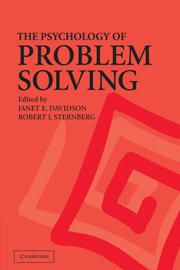Book contents
- Frontmatter
- Contents
- Contributors
- Preface
- PART I INTRODUCTION
- PART II RELEVANT ABILITIES AND SKILLS
- PART III STATES AND STRATEGIES
- 8 Motivating Self-Regulated Problem Solvers
- 9 Feeling and Thinking: Implications for Problem Solving
- 10 The Fundamental Computational Biases of Human Cognition: Heuristics That (Sometimes) Impair Decision Making and Problem Solving
- 11 Analogical Transfer in Problem Solving
- PART IV CONCLUSION AND INTEGRATION
- Index
- References
10 - The Fundamental Computational Biases of Human Cognition: Heuristics That (Sometimes) Impair Decision Making and Problem Solving
Published online by Cambridge University Press: 05 June 2012
- Frontmatter
- Contents
- Contributors
- Preface
- PART I INTRODUCTION
- PART II RELEVANT ABILITIES AND SKILLS
- PART III STATES AND STRATEGIES
- 8 Motivating Self-Regulated Problem Solvers
- 9 Feeling and Thinking: Implications for Problem Solving
- 10 The Fundamental Computational Biases of Human Cognition: Heuristics That (Sometimes) Impair Decision Making and Problem Solving
- 11 Analogical Transfer in Problem Solving
- PART IV CONCLUSION AND INTEGRATION
- Index
- References
Summary
Consider the following syllogism. Ask yourself whether it is valid – whether the conclusion follows logically from the two premises:
Premise 1: All living things need water.
Premise 2: Roses need water.
Therefore, Roses are living things.
What do you think? Judge the conclusion either logically valid or invalid before reading on.
If you are like about 70% of the university students who have been given this problem, you will think that the conclusion is valid. And if you did think that it was valid, like 70% of university students who have been given this problem, you would be wrong (Markovits & Nantel, 1989; Sá, West, & Stanovich, 1999; Stanovich & West, 1998c). Premise 1 says that all living things need water, not that all things that need water are living things. So just because roses need water, it doesn't follow from Premise 1 that they are living things. If that is still not clear, it probably will be after you consider the following syllogism with exactly the same structure:
Premise 1: All insects need oxygen.
Premise 2: Mice need oxygen.
Therefore, Mice are insects.
Now it seems pretty clear that the conclusion does not follow from the premises. If the logically equivalent “mice” syllogism is solved so easily, why is the “rose” problem so hard? Well for one thing, the conclusion (roses are living things) seems so reasonable and you know it to be true in the real world. And that is the rub.
- Type
- Chapter
- Information
- The Psychology of Problem Solving , pp. 291 - 342Publisher: Cambridge University PressPrint publication year: 2003
References
- 39
- Cited by

